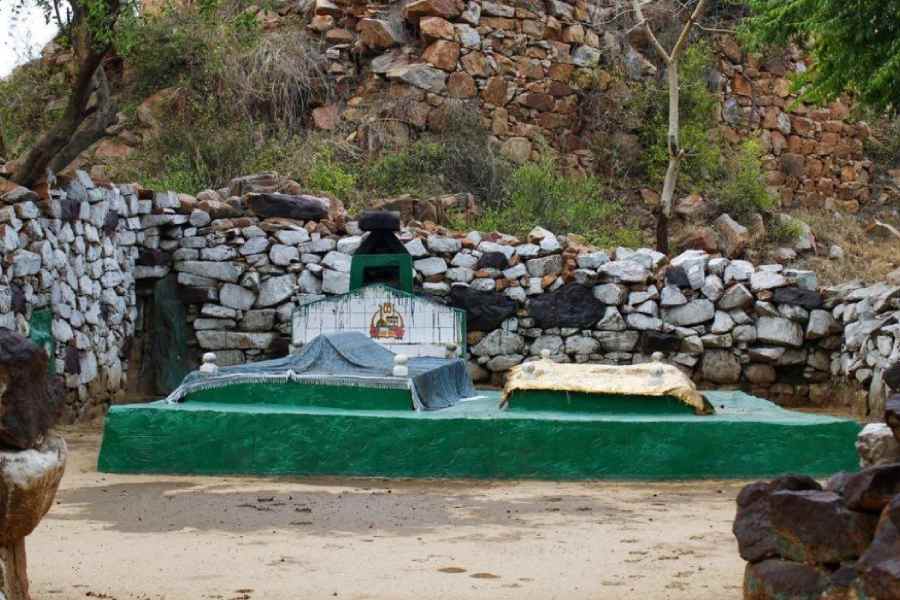Demolitions of religious structures near the Qutub Minar, some of which are several centuries old, have led to an outcry.
Delhi High Court has ordered a status quo at the site but the area remains cordoned off by central forces and fears of more demolitions remain.
On January 30, the Delhi Development Authority (DDA) razed the Akhoondji Mosque, the adjacent Madrasa Bahrul Uloom, and a cemetery in Sanjay Van — a reserved forest near the Qutub Minar — as well as a Kali temple in Mehrauli close by as part of the drive to remove “encroachments” — an action now under challenge in the high court.
Several Sufi shrines, including tombs and a well, have also been demolished.
The exact age of the Akhoondji Mosque is not known. However, according to an Archaeological Survey of India (ASI) report of 1922, it was repaired in 1853-54.
Historian William Dalrymple posted a file photo of the mosque on X and wrote: “But the arch on the left is clearly Sultanate in style, and while much of the demolished structure is no doubt a modern reconstruction, it seems highly likely that it was built on the ruins of a Sultanate mosque/ dargah/ khanqah, and these structures should have been carefully preserved, even if the modern buildings were determined as an unauthorised encroachment.”
The action by the DDA, which operates under the Union ministry of housing and urban affairs, has come at a time several Muslims are speaking out against a court granting permission for Hindu prayers to be conducted at the Gyanvapi Mosque in Uttar Pradesh’s Varanasi.
Congress MP Imran Pratapgarhi raised this in the Rajya Sabha during Zero Hour on Monday. He said in the House: “The Prime Minister who took a selfie, smiling in the Sheikh Zayed mosque in Abu Dhabi, why can’t he hear the screams of the 700-year-old Akhoondji Mosque in Mehrauli being demolished?”
Pratapgarhi added: “The DDA, which was founded in 1957, is terming as encroachment the Mehrauli mosque that is many hundred years older than it. Do development authorities not adhere to the Places of Worship Act, 1991?”
The act, which conserves the religious character of places of worship as they were at the time of Independence, is in question in the Gyanvapi case. While Pratapgarhi got the support of several Opposition parties, BJP MP Harnath Singh Yadav demanded the repeal of the act.
The demolished structures were not protected monuments under the ASI or the Delhi Archaeology Department, which collectively protect less than a fifth of Delhi’s 1,208 recognised monuments.
Historian Rana Safvi told The Telegraph: “Monuments existing for centuries can’t possibly be encroachments on Sanjay Van (that was declared a reserve forest in 1994). The DDA cannot just demolish like this in an area filled with monuments.”
Mehrauli witnessed large-scale demolition of slums last year, some of which were allegedly encroaching into designated monument premises. Hindutva groups have also been demanding that temples be set up inside the Qutub Minar premises. Sanjay Van is on the southern Delhi ridge where leopards and other endangered species are spotted.
Zakir Husain, the cleric of the Akhoondji Mosque, lost all his belongings in the sudden demolition at dawn that he says was without notice. Now in a rented premises in Mehrauli, he told this paper: “People have no place to bury their dead now. The 25 children of the madrasa were left out in the cold that morning until we moved them to the Kala Mahal madrasa (in the area).”

Remains of the 12th-century tombs of Baba Haji Rozbih and his disciple near Delhi's Qila Rai Pithora after demolition. Picture courtesy Sair e Hind's Instagram page
A CPIML-Liberation fact-finding report said: “Although peace and harmony prevail among communities in Mehrauli, actions like selective evictions (reportedly of Muslim hawkers) and compensatory demolition (of a temple as well) threaten to polarise the area. Delhi has been on the boil since January 22.”
Heritage conservationist Sohail Hashmi said: “The DDA has planted non-native trees, created a badminton court, started yoga classes, and plans a paragliding facility in Sanjay Van. It has ignored the garbage dumps and farmhouses that have come up here. It is turning this forest into a garden for the affluent residents of Vasant Kunj (nearby).”
A DDA spokesperson did not respond to calls and messages from this paper.










